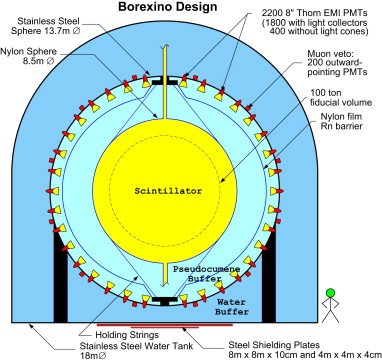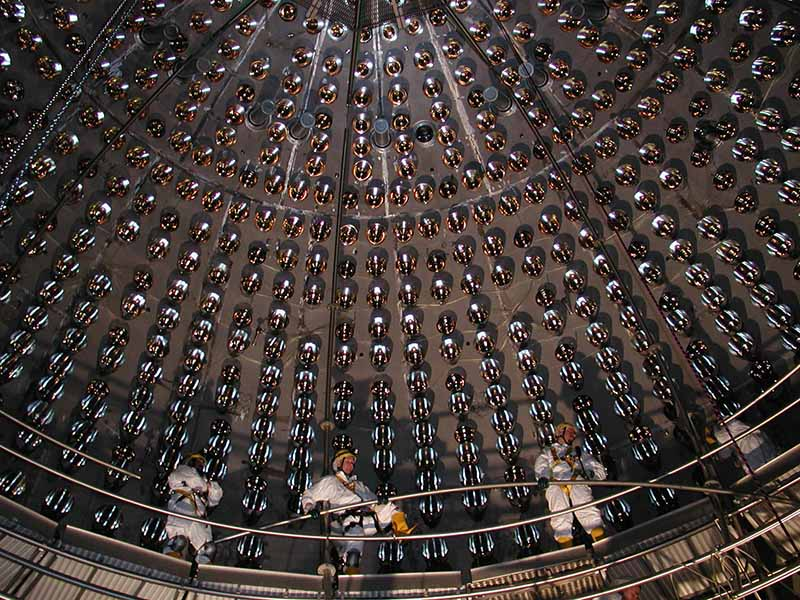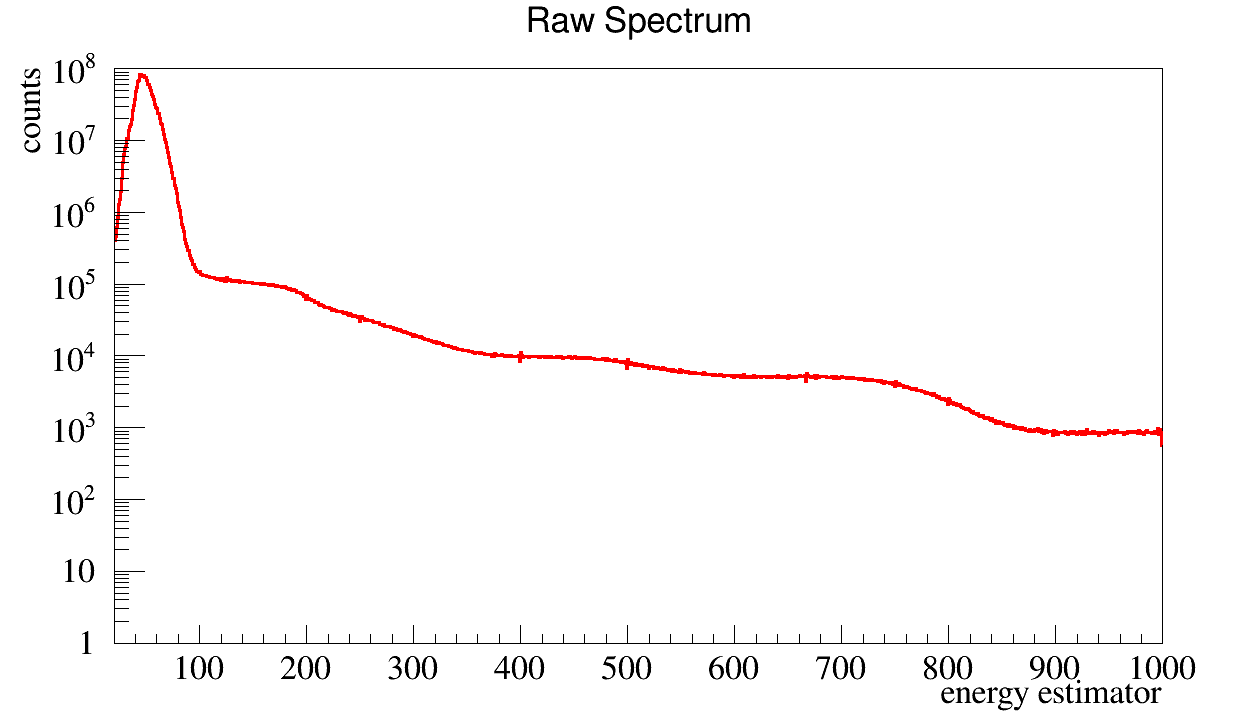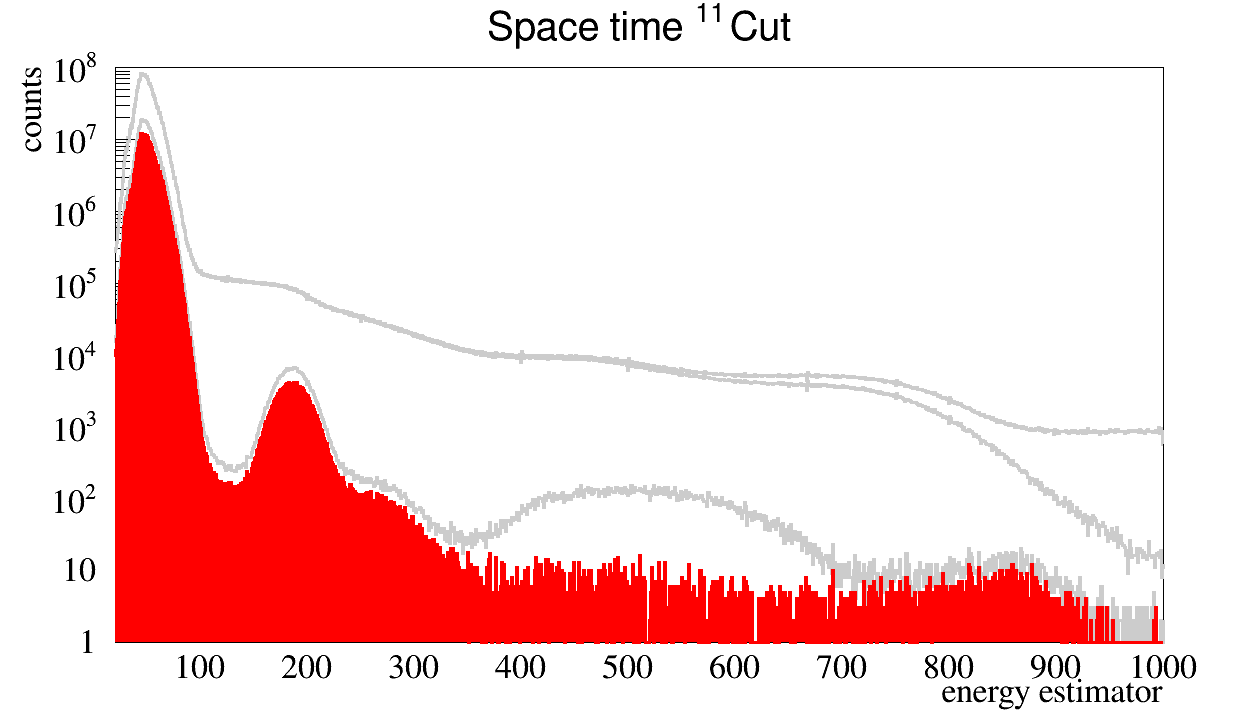
They come from the core of the sun, they are among the most elusive particles of the Universe and very large and radio pure detectors are necessary to detect them.
A typical detector of solar neutrinos is composed by a very large volume of a liquid, in which the passage of neutrinos can cause very faint flashes of light. These ‘’sparks’’ are captured by instruments.
Neutrinos are neutral elementary particles (i.e. they have no electric charge) and they are interesting for the study of many phenomena from astrophysics, to cosmology and particle physics. Except for photons, they are the lightest particles known as yet, with a mass at least a million times smaller than the electron and are, after the photons, the most abundant particles in the Universe (as far as we know). They can belong to three families – or flavors – named after the corresponding charged particles: electron neutrino, muon neutrino and tau neutrino, whose counterparts are electron, muon and tauon respectively. Neutrinos do not interact through electromagnetic or strong nuclear forces, but only through the other two fundamental forces: gravitational and weak. However, the gravitational force is negligible, since neutrino masses are extremely small. The weak nuclear force acts at a very short distance, so it is unlikely for a neutrino to interact with matter and this is why they are referred to as the most elusive particles of the Universe.
Neutrinos are elusive but numerous, just think that a stream of hundreds of billions of these particles go right through our bodies every second! It is a continuous and completely harmless “bombardment”, precisely because they are so elusive. The Universe is full of sources in which neutrinos are produced in abundance. The one closest to us is the Sun and that is where most of the neutrinos passing through the Earth are from. Nuclear fusion reactions among hydrogen atoms take place in the innermost part of the Sun and other stars which is what keeps them glowing. Here the enormous thermal energy present make the protons overcome their electrical repulsion thus merging into helium nuclei, emitting electrons, photons and neutrinos in the process. The latter, due to their low propensity to interact with anything, move away from the star very fast and undisturbed. When a star explodes many neutrinos are formed and despite the enormous distances they can even reach the Earth. For example, such an event occurred on February 27, 1987, when our planet was hit by an intense flux of neutrinos produced by a supernova – the explosion of a massive star that ran out of its nuclear fuel – more than 160 thousand light-years distant. It is estimated that about 10,000 billions of neutrinos produced by that explosion have passed through every human being. However, let’s get back to the Sun. Once they are produced the neutrinos move away at a speed very close to the speed of light: they reach the Earth after only an 8 minute trip, carrying valuable pieces of information about the core of our star.
What are the fundamental characteristics that an efficient system must have for detecting solar neutrinos? Since the cross section of interaction (term used by physicists to indicate the probability of interacting with matter) between neutrinos and atoms is extremely small you need detectors equipped with a very large “target” mass in order to detect their presence and study their properties. This way neutrinos are given the chance to encounter as much sensitive material as possible with which to interact as they move along, making the best use of the huge number of neutrinos passing through the Earth every second (about 60 billion per cm 2) and compensating for their tiny cross section. A neutrino detector should also be shielded as much as possible from natural radiation. In fact, there are many events of a different nature that can generate “false positives”, i.e. misleading signals due to the passage of other particles which are much more capable of interacting than neutrinos. These need to be checked as much as possible. The location of the LNGS, placed under a natural shield of 1400 m of rock, is in this sense strategic because it allows us to lessen by 6 orders of magnitude one of these primary sources of noise: the muons produced by cosmic ray interaction in the atmosphere (see muon veto). This is the main reason why many LNGS experiments have been focused on neutrino physics in general and, in particular, the study of solar neutrinos. For example, six experiments (MACRO, Gallex, GNO, OPERA, Icarus, Borexino) hosted by LNGS led to the important discovery of a phenomenon called oscillation – through which neutrinos travelling in space can change their flavor over time. Of these six only the last one is still active: Borexino.
Borexino aims to measure low-energy solar neutrinos, the most difficult to be detected. At the heart of the Borexino experiment is a huge spherical tank filled with 900 tons of liquid hydrocarbon, which shields yet another 300 tons of liquid scintillator contained in a nylon sphere (see scintillator). A liquid scintillator is a material able to emit a spark of light when a neutrino hits one of the approximately 1030 electrons that make it up. This large sparkling heart is placed inside a tank containing 2400 tons of ultra-pure water which acts as an additional active shield (via Cherenkov light) for cosmic rays (muons) and passively also for neutrons produced by environmental radiation (seemuon veto). In fact, Borexino is a really impressive experiment not only for its dimensions but also for the level of suppression of the source of spurious signals called background radiation. This is composed of the cosmic rays mentioned above, which are lessened by the rock and then “unmasked” by the muon veto, but also by the natural radioactivity coming from the environment and from the materials which the detector is made of. Background radiation is completely unnoticeable to us, but it is incredibly high compared with the sensitivity required by experiments such as Borexino, which requires a level of one billion times less radioactivity than anything on the Earth. For example, in 1 litre of spring water there are approximately 10 radioactive decays per second from contaminants, while in 1 kg of Borexino scintillator 10 decays occur in more than 300 years. For this reason, both the 2400 tons of water and the 1300 tons of scintillator undergo a sophisticated purification process which, combined with the effect of the rock shield above the LNGS, lead to a record result: currently the heart of Borexino is the least radioactive place in the Universe!

Diagram of the Borexino experiment. (Credits : Laboratori Nazionali del Gran Sasso (INFN) – Paolo Lombardi).
What happens in practice inside the detector? Rarely (a few dozen times a day) does one of the many neutrinos that pass through the detector hit an electron of the scintillator molecules producing a spark. It is a faint flash of light, so brief and so weak that it can be picked up only by extremely sensitive instruments called photomultipliers (see Solar neutrinos/Photomultiplier pages). The 2200 photomultipliers on the inner surface of the Borexino sphere pick up the faintest glow, even a single photon, and amplify it into an electrical signal.

Inner part of the vessel in which the scintillator is placed. The bulbs are placed on the wall.
From the shape of this signal we can understand the energy and position of the neutrino that generated it. Subsequently a spectrum can be determined (see spectrum), a diagram which, for given time intervals, records the number of neutrinos observed as a function of their energy. The latter is the result of sophisticated processing of the data collected, in which, one by one, all of the noise components that generate unwanted signals are removed: the muons produced by cosmic rays; the radiations emitted by the walls of the detector; the signals produced spontaneously by the scintillator. When data analysis has been completed, the comparison between the spectrum obtained and the prediction from the theoretical model that describes the Sun (the Standard Solar Model) allows us to verify – and if necessary modify – our knowledge of nuclear reactions that occur inside our star, as well as the structure and the composition of its nucleus. The spectrum – number of sparks observed as a function of their energy – before data analysis.

The spectrum – number of sparks observed as a function of their energy – before data analysis.

The same spectrum after data analysis, when all the components that generate noise have been removed.

Discover the experiments and help the alien to get back home!
Play now